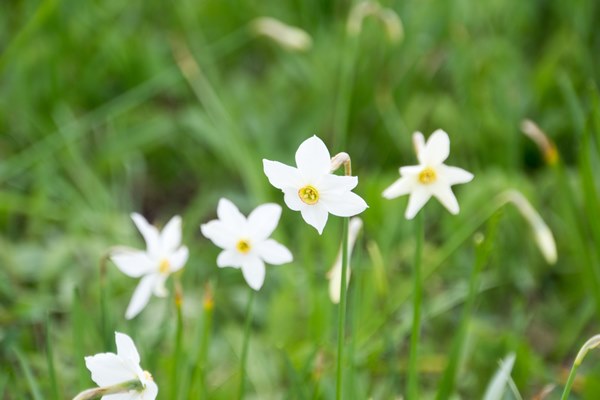Narcissus : Poetry in Perfume

Thank you very much for your interest in my Ukrainian Perfumery Seminar, which I will run with Olga Gritsenko on March 14th via Zoom. We still can accommodate a couple of people.
March 14, Friday, 12:00-13:00 EST
50€ Book Now (recording available)The proceeds will benefit Kyiv’s Children Art School, which offers free art classes to children and supports their healing process. Thank you for your generous support. Donate Now
Every spring, the hills near Aubrac, a village in the department of Lozère in southern France, are draped in a carpet of daffodils. Narcissus poeticus is renowned for its fragrance, and the narcissus of Lozère has such a sweet, rich aroma that it’s one of the few varieties used in perfumery. Its essence is also one of the most expensive, since not only does a kilogram of narcissus absolute require a whole field of flowers, the process of obtaining the aromatic substance from the petals is complex and time consuming.

The result, however, is prized, because distilled narcissus has a fragrance unlike any other blossom. It smells of sun warmed petals, but also of leather, warm spices and earth. It never fails to amaze me how such a delicate spring flower can hide an autumnal aroma and such a range of nuances.
Perfumers have long recognized this paradox of narcissus and have used its essence to convey the contrast and drama between flowers and woods. Vol de Nuit, one of the crown jewels of Guerlain, was created in 1933 in homage to the aviators of the 1920s. Its name is inspired by the eponymous novel by Antoine de Saint-Exupéry and its composition relies on the interplay of light and dark. Narcissus crowns the central accord of moss, sandalwood, musk and tonka bean. Its leathery darkness plays up the smoky, earthy edge of Vol de Nuit, while its brightness makes the composition seem airy and transparent.
Because of the high price of its essence, narcissus is often a secondary player in perfume formulae. Rose or jasmine can be suggested with a clever combination of aroma-materials, but narcissus is too unique to be easily replicated. It’s also considered a difficult note to tame because of its bold character. Some perfumers, however, find narcissus fascinating enough to allow it to take center stage.
When perfumer Jean-Claude Ellena embarked on a journey to capture the essence of the delicate narcissus, he found inspiration in the lush landscapes and vibrant blooms of nature. This exploration led to the creation of Hermès Eau de Narcisse Bleu, a fragrance that beautifully encapsulates the serene yet mysterious aura of the flower. In this composition, the narcissus unfolds, revealing its green, crisp facets that evoke the freshness of spring mornings. Ellena enhances its floral elegance with hints of grapefruit and zesty bergamot, adding a lively brightness that dances on the skin. The heart of the fragrance is wrapped in soft, powdery notes, which gracefully intertwine with a base of gentle woods and musks, creating a refined and sophisticated finish that lingers delicately, embodying the timeless elegance of Hermès.
Narcissus can convey many moods, from seductive to bucolic. The latter impression is what I enjoy in Dryad, a fragrance from an artisanal British house, Papillon Perfumery. The perfumer Liz Moores weaves moss, salty vetiver, and green, balsamic notes with narcissus to evoke a walk in the forest. Yet, Dryad’s is not the manicured grove with neatly laid out paths and trimmed trees. It’s a wild, mysterious place where one could get lost, happily. Dryad’s woodland is autumnal, filled with fallen crimson leaves and chestnut shells, but the whisper of narcissus is a reminder of blossoms, sunshine and spring.
What are your favorite spring flower perfumes?
Extra reading: 20 Best Narcissus and Daffodil Perfumes
Photography by Bois de Jasmin
